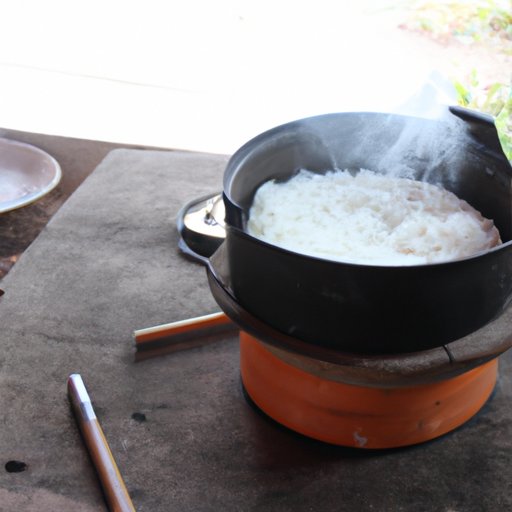Introduction
Rice has been a staple in many cultures around the world for centuries. Today, it is one of the most widely consumed grains, and is a popular choice for those looking to incorporate more whole grains into their diets. But is rice a healthy carbohydrate? This article examines the nutritional profile of rice, compares white and brown rice, and discusses how to incorporate rice into a balanced diet.
Examining the Nutritional Profile of Rice: Is it a Healthy Carb?
Rice is a type of cereal grain, and is typically categorized as a complex carbohydrate. It is composed of three parts: the germ, bran, and endosperm. The germ and bran layers contain the majority of the vitamins, minerals, and fiber found in rice, while the endosperm contains mostly carbohydrates and proteins.
When it comes to the nutritional value of rice, it has several key components that make it a healthy choice. It is low in fat and sodium, and is a good source of essential vitamins and minerals such as thiamin, niacin, and folate. Additionally, rice is a good source of dietary fiber, which helps promote digestive health and regularity.
Rice is also a good source of plant-based protein, which is important for building and repairing body tissues. Furthermore, some types of rice, such as brown rice, contain significant amounts of antioxidants, which can help protect against cell damage caused by free radicals.
A Comparison of White and Brown Rice: Which is Healthier?
When it comes to choosing between white and brown rice, there are several factors to consider. Nutritionally speaking, both types of rice offer similar amounts of calories, carbohydrates, protein, and fiber. However, there are a few key differences between the two.
White rice has had its husk, bran, and germ layers removed during processing, leaving only the endosperm. As a result, white rice is lower in fiber and other vitamins and minerals than brown rice. Brown rice, on the other hand, retains its outer layers, making it higher in fiber, vitamins, and minerals. Additionally, brown rice is a better source of antioxidants than white rice.
Overall, brown rice is considered the healthier option because it is higher in fiber and other nutrients. However, both types of rice can be part of a healthy diet when eaten in moderation.

The Impact of Refined and Unrefined Rice on Blood Sugar Levels
In addition to considering the nutritional differences between white and brown rice, it is important to understand how different types of rice affect blood sugar levels. Refined rice, such as white rice, has a higher glycemic index (GI) than unrefined rice, such as brown rice. The GI is a measure of how quickly carbohydrates are broken down and absorbed into the bloodstream. Foods with a high GI cause a rapid rise in blood sugar levels, which can lead to health problems like diabetes and obesity.
Unrefined rice, on the other hand, is lower on the GI scale and therefore does not cause such a rapid spike in blood sugar levels. Additionally, unrefined rice is higher in fiber, which helps slow digestion and absorption of carbohydrates, further reducing the impact on blood sugar levels.
How to Incorporate Rice into a Healthy Diet
Eating a balanced diet is key to maintaining overall health and wellness. Rice can be incorporated into a healthy diet by substituting it for other starches, such as potatoes or pasta. Additionally, adding vegetables and lean proteins to meals containing rice can increase the nutritional value and make them more filling.
It is also important to note that portion size matters when it comes to consuming rice. The recommended serving size is ½ cup cooked, which is about the size of a fist. Eating too much rice can lead to weight gain, so it is important to monitor portions and consume in moderation.

Cooking Techniques That Enhance the Health Benefits of Eating Rice
There are several different cooking techniques that can be used to prepare rice, each of which can have an impact on the nutritional value. Boiling rice is one of the most common methods, and it is relatively simple and quick. However, boiling rice can reduce the nutrient content, so it is best to use minimal water and cook until just tender.
Another popular cooking method for rice is steaming, which helps to retain the vitamins and minerals in the rice. Steaming also helps to reduce the amount of starch released into the cooking liquid, which can help prevent spikes in blood sugar levels. Lastly, baking or roasting rice can add flavor and texture to dishes, while still providing the same nutritional benefits.
Conclusion
Rice is a nutritious and versatile food that can be incorporated into a healthy diet. While white rice is lower in fiber and other vitamins and minerals than brown rice, both types can be included in moderation. To maximize the health benefits of eating rice, it is important to consider the glycemic index, portion size, and cooking techniques. With careful consideration, rice can be a healthy and delicious addition to any meal.
(Note: Is this article not meeting your expectations? Do you have knowledge or insights to share? Unlock new opportunities and expand your reach by joining our authors team. Click Registration to join us and share your expertise with our readers.)
